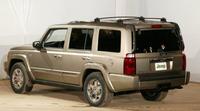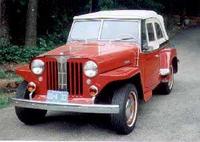2006 Jeep Commander Limited Review
DRIVING DOWN THE ROAD
WITH CAREY RUSS
SEE ALSO: New Car Buyer's Guide for Jeep
2006 Jeep Commander Limited
What was the first sport-utility vehicle as we now understand the genre? Any answer is bound to be controversial, but the Willys-Overland, produced from 1946 through 1962, and the Jeep Wagoneer, its successor from 1963 through 1991, stand out as some of the earliest fully off-road capable four-wheel drive vehicles civilized enough for everyday use in town. The Willys-Overland, while having only two doors, even had a seven-passenger capacity thanks to a jump seat behind the second-row bench. When it debuted in 1984, the Jeep Cherokee offered four doors as well as the then-standard two, and was designed to be as capable in the city as it was off road.
Interestingly, despite the SUV boom of the 1990s, fueled in large part by vehicles like Jeep's own Cherokee and Grand Cherokee, the Wagoneer was the last large Jeep. It's taken until now, with the 2006 Jeep Commander, to fill that void in the lineup.
If it builds on the heritage and style of the Overland, Wagoneer, and Cherokee, the Commander is most akin to the current Grand Cherokee. Unsurprisingly, as it's built on the Grand Cherokee platform. Although the Commander is only two inches longer than the Grand Cherokee, and very different in style, the two vehicles share a 109.5-inch wheelbase. But the Commander is significantly larger inside, and was designed from the beginning to have three rows of seating.
For trim level, power, and off-road capability, choices abound. Choose between the standard Commander or the luxury-class Limited. The standard model comes with a 3.7-liter, 210-horsepower V6, with the 235-hp 4.7-liter V8 optional. The Limited gets more chrome outside, and leather inside, and the 4.7 V8 under the hood, with the 5.7-liter, 330-hp version of the HEMI V8 optional. All have a five-speed automatic transmission. Suspension for all models is by independent short and long arms in front, with a live axle with multi-link location in the rear. Brakes are four-wheel antilock discs. Both models are available with two- or four-wheel drive, with the V6 having a full-time single-range system and the V8s using a dual-range system with full-time active four-high.
I've just spent a week with a HEMI-equipped Commander Limited. What impressed me the most? It's ride comfort and suspension refinement. It wasn't just ``comfortable for a Jeep,'' it was comfortable, period, with very good suspension action and damping, and minimal body lean. Good interior space was another high point, although the third row, as in any less-than-humongous SUV, is best used by children. No power shortage with the HEMI, either. And, despite the larger interior, it's not so large as to be a major pain to park - and that means, for those who dare, trails should be great fun. Hey, it is a Jeep, after all, and Jeep tests all of its vehicles in extreme conditions just because they're Jeeps.
APPEARANCE: Although the Commander pays tribute in sheet metal to the Willys-Overland, the Wagoneer, and the Cherokee, it has a look that, while undisputedly Jeep, is all its own. The Jeep characters are there for the world to see - a boxy, utilitarian shape, the seven-slot grille - chrome-plated on the Limited - and trapezoidal wheel arches, first introduced on the Wagoneer, which here are emphasized by the similar shape of the fender flares decorated with faux chromed hex bolts. Although it's nearly six feet high, its height doesn't readily show, due to the relatively low and long passenger cabin. A near-vertical windshield windshield gives the Commander a military bearing. A step in the roof above the second row aids passenger headroom. The rear styling is simple and angular.
COMFORT: The Commander makes good use of the space available from its body design, and in Limited trim is quite luxurious. The design motif is upscale contemporary, with, in the Limited, leather seating and woodgrain trim. Ventilation should not be a problem - there are eight directable vents on the dash plus additional vents for the second and even third row passengers. Front and second-row seat comfort is very good, with plenty of head and leg room, but the third row is best left for two people under five and a half feet tall. Access is average, but is helped by a second-row seat that splits in thirds. With the third row in passenger position, cargo space behind is limited, as is rearward visibility. With it down, there is plenty of cargo space - and the three-piece second row adds to versatility. The second and third row cushions are higher, theater-style, thanks to the raised roofline. Which also helps when viewing the optional entertainment center's LCD screen, mounted on the second-row ceiling. There are useful storage spaces around the cabin. The ``CommandView'' second-row skylights are a pleasant feature.
SAFETY: Standard safety equipment in the Commander Limited includes multi-stage front airbags with the Occupant Classification System, side and side-curtain airbags, Brake Assist, the ESP electronic stability control system, and Electronic Roll Mitigation. Brakes are four-wheel antilock disc, and four-wheel traction control is also standard. The ParkSensor system alerts the driver to obstacles when backing.
RIDE AND HANDLING: Like every Jeep, the Commander is designed to be capable of rugged off-road use. The compromises between the demands of extreme off-road duty and everyday use have, in the past, sometimes resulted in Jeep suspensions that didn't exactly give a ``car-like'' ride. Not the case with the Commander. It's a remarkably comfortable machine on the street, and can take the hazards of urban driving - broken pavement, potholes, curbs, car parts, and other surprises - in stride. It felt stable and solid, never tippy, controlling body roll well. But the ride, while firm in the most positive manner, is not at all soft. A relatively small 37-foot turning circle and light steering are as useful in a crowded parking lot as on a boulder-strewn trail. 8.6 inches of clearance under the rear differential and available skid plates to protect the fuel tank, transfer case, and front suspension are as useful when road debris suddenly appears on the highway as on the trail, too. 4x4 Commanders equipped with the 5.7-liter HEMI get Jeep's Quadra-Drive II system, with full-time 4-hi for optimum traction in all reasonable conditions. It can route up to 100 percent of the available torque to the axle that can best use it, and electronic limited-slip front, center, and rear differentials ensure that the one tire that can find traction will. It also has a 4-low range for those times when the going is tough.
PERFORMANCE: Need power to tow up to 7200 lbs? That's why Jeep offers the 5.7-liter HEMI in the Commander. Like its namesakes from the past, its 16 valves are pushrod-operated and the block is sturdy cast iron. The seemingly-archaic pushrod architecture makes it easier to implement the ``Multi-Displacement'' system, which deactivates four cylinders under low-load conditions for improved fuel economy. After all, 330 horsepower (at 5000 rpm) and 375 lb-ft of torque (at 4000 rpm) are not necessary all of the time - but when that power is needed, for passing, towing, or just because, it's most definitely there. The HEMI Commander can move pretty quickly for a 5200-lb vehicle. It's aided by a five-speed automatic transmission with manual-shift mode.
CONCLUSIONS: Jeep blazes new territory with the seven-passenger Commander.
SPECIFICATIONS
2006 Jeep Commander Limited
Base Price $ 38,205
Price As Tested $ 43,700
Engine Type pushrod overhead valve 16-valve V8,
cast iron block and aluminum alloy
heads
Engine Size 5.7 liters / 345 cu. in.
Horsepower 330 @ 5000 rpm
Torque (lb-ft 375 @ 4000 rpm
Transmission 5-speed automatic with
manual shift mode.
Wheelbase / Length 109.5 in. / 188.5 in.
Curb Weight 5169 lbs.
Pounds Per Horsepower 15.6
Fuel Capacity 20.5 gal.
Fuel Requirement 89 octane unleaded mid-grade gasoline
Tires P245/65 SR17 Goodyear Fortera HP
Brakes, front/rear vented disc / solid disc,
anti-lock standard
Suspension, front/rear independent short-and-long arm,
coil springs /
live axle, multilink location
and coil springs
Ground Clearance 8.6 inches at the rear axle
Drivetrain front engine, on-demand
four-wheel drive
PERFORMANCE
EPA Fuel Economy - miles per gallon
city / highway / observed 15 / 19 / 14
0 to 60 mph est 8.0 sec
Towing Capacity 7200 lbs (5.7-liter engine)
OPTIONS AND CHARGES
Electronic Infotainment System Group - includes:
rear overhead console and video system $1,200
Trailer Tow Group $ 255
Off-Road Group 1 - includes:
skid plate group: tow hooks, fuel tank skid plate
shield, transfer case skid plate shield, front
suspension skid plate $ 225
Saddle brown seats $ 150
5.7-liter HEMI mult-displacement engine
with Quadra-Drive II4WD system and
electronic limited slip front and rear
differentials $1,495
Navigation system $1,200
L-Connect hands-free communication $ 275
Destination charge $ 695




